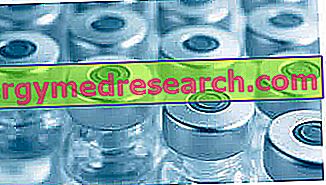What are solar lentigo?
Among the disorders that affect the pigmentation of the skin, solar lentigo are the result of excessive and unregulated exposure to the sun. In clinical practice, in fact, solar lentigo - as well as a good part of skin blemishes - are closely related to seasonal variability.

Features
They manifest themselves as patches of irregular shape, not well defined, and of variable size: the solar lentigo, in fact, can be of small dimensions and result almost imperceptible to the eye, or evolve also involving very large areas of the skin. Even the color of solar lentigo is not the same for all subjects: in fact, the color of the spots can vary from yellow to hazel, from brown to brown.
The solar lentigo represent only a temporary imperfection of the skin and do not entail pathological consequences. In general, the opinion of the dermatologist is not indispensable, considering that often the solar lentigo portray a reversible phenomenon: however, in the case in which the sunspots are so large as to disfigure the image of the subject, the expert's opinion is always adequate.
Incidence
Solar lentigo occur indifferently in both male and female individuals.
Although this disorder can also occur in children and young adults, it has been recorded that solar lentigos - in addition to affecting the areas most affected by the sun - occur most frequently in subjects over fifty. The skin of these people, in fact, shows a slower cell turnover than the young, due to the repeated light exposures.
Causes
The solar lentigo are linked to an alteration of the melanogenesis, that is to say to a modification of the processes that regulate the production of melanin (pigment that colors the skin): it is therefore a hypermelanosis (cutaneous accumulation of melanin). As the word itself recalls, it is the sun, therefore, the triggering cause of solar lentigo, as it involves an early aging of the skin associated with alterations in the mechanisms of melanogenesis (including, for example, melasma-chloasma, lentigo senili, solar lentigo) .
variants
In addition to the classic solar lentigos that manifest themselves as a consequence of excessive and incorrect (without protection, for example) sun exposure, there is a particular form of solar lentigo that occurs in patients who undergo PUVA therapy for prolonged periods (generally, over two years).
PUVA therapy is a special treatment that is carried out in the case of particular skin diseases, such as, for example, vitiligo.
It has been estimated that as many as 25% of the patients who undergo this therapy for long periods of time develop this variant of solar lentigo which, however, is histologically different from the "classic" solar lentigo caused by exposure to the sun.
Treatments
If the solar lentigo does not regress over time, the dermatologist can guide the patient in choosing possible resolutive therapies, such as peeling, laser, liquid nitrogen, lightening substances and IPL pulsed light.
Chemical peeling
Local chemical peeling at high concentration should be carried out using trichloroacetic acid (which burns sunspots), retinoic or glycolic acid. Peeling is useful for eliminating the blemish caused by sun lentigo: by removing the superficial horn layers, skin regeneration is achieved. The peeling treatment is carried out by the dermatologist directly on the sun lentigo, taking care not to damage the "healthy" skin that surrounds the spot. At the point where the peeling takes place, a sort of film is created which at first appears white, after which it becomes red because the skin is stressed and irritated.
The peeling is a rather annoying treatment for the patient, because it feels a burning sensation, even if momentary. The result will still be satisfactory.
Lightening substances
The depigmented substances represent another solution model for solar lentigo: hydroquinone and cogic acid, associated with retinoic and glycolic acid (exfoliants), are a valid aid.
Laser
Another useful technique in the resolution of solar lentigo is the laser, a less painful treatment than peeling. However, it is good to remember that the affected patient should undergo several sessions for the total elimination of lentigo, although in this sense the ability of the dermatologist who performs the therapy has a great influence. The laser affects the melanin pigment and is removed by trans-dermal route, as the macrophages "absorb" the excess melanin. However, the side effects are not lacking: in the 24 hours post-treatment, the skin could show swelling and redness, however completely reversible effects.
Liquid nitrogen
The technique that uses liquid nitrogen to counter solar lentigo (and skin blemishes in general) is called cryotherapy : through a special instrument, the skin is placed in contact with liquid nitrogen which, acting at very low temperatures, allows to create a real cold burn that promotes the elimination of solar lentigo.
IPL pulsed light
Another decisive technique for the treatment of solar lentigo is represented by the pulsed light IPL: the technique consists in the use of pulsed light - combined with the aid of special filters - which reaches the melanin. As the light strikes the lentigo, there is a browning of the stain: afterwards, the solar lentigo becomes lighter, and then slowly peels off until it clears completely.
Dermabrasion
Dermabrasion is a technique that allows mechanical and controlled removal of the superficial layers of the skin. This removal is carried out using special tools equipped with diamond micro-cutters, or micro-steel brushes.
Of course, dermabrasion must be performed only and exclusively by specialized medical personnel.
At the end of the treatment, the skin undergoes the classic punctate bleeding and the patient may experience burning, tension and swelling of the treated area.
Although normally well tolerated, dermabrasion is probably one of the most troublesome treatments for the patient.
Microdermabrasion
Microdermabrasion is a softer technique than the aforementioned dermabrasion. It is also able to eliminate solar lentigo by mechanically removing the surface layers of the skin. To do this, the microdermabrasion makes use of the use of special instruments that exploit the action of particular physical exfoliants.
Although delicate and optimally tolerated by most patients, microdermabrasion is not without side effects: at the end of the treatment, redness, pain and irritation of the skin may occur.
diathermocoagulation
Diathermocoagulation is a technique used in dermatology that can also be used in the removal of solar lentigo. The elimination of these imperfections is carried out through the use of an electrosurgical unit (diatermocoagulator).
It is a more "aggressive" treatment than those discussed so far which can cause pain and burning and, for this reason, it is performed under local anesthesia.
However, although relatively non-invasive, diathermocoagulation is a real intervention that must therefore only be carried out by specialized doctors.
The possible side effects resulting from this treatment consist of: redness, pain, burning and swelling. The possible complications are represented by the formation of keloid scars or by the hyper- or hypopigmentation of the treated areas.



